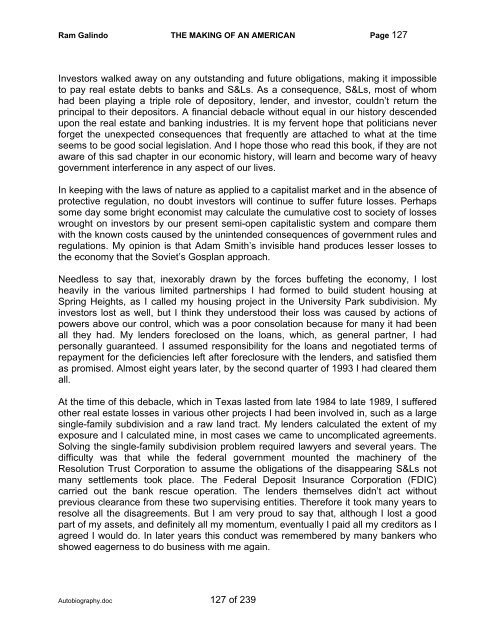Autobiography - The Galindo Group
Autobiography - The Galindo Group
Autobiography - The Galindo Group
Create successful ePaper yourself
Turn your PDF publications into a flip-book with our unique Google optimized e-Paper software.
Ram <strong>Galindo</strong> THE MAKING OF AN AMERICAN Page 127<br />
Investors walked away on any outstanding and future obligations, making it impossible<br />
to pay real estate debts to banks and S&Ls. As a consequence, S&Ls, most of whom<br />
had been playing a triple role of depository, lender, and investor, couldn’t return the<br />
principal to their depositors. A financial debacle without equal in our history descended<br />
upon the real estate and banking industries. It is my fervent hope that politicians never<br />
forget the unexpected consequences that frequently are attached to what at the time<br />
seems to be good social legislation. And I hope those who read this book, if they are not<br />
aware of this sad chapter in our economic history, will learn and become wary of heavy<br />
government interference in any aspect of our lives.<br />
In keeping with the laws of nature as applied to a capitalist market and in the absence of<br />
protective regulation, no doubt investors will continue to suffer future losses. Perhaps<br />
some day some bright economist may calculate the cumulative cost to society of losses<br />
wrought on investors by our present semi-open capitalistic system and compare them<br />
with the known costs caused by the unintended consequences of government rules and<br />
regulations. My opinion is that Adam Smith’s invisible hand produces lesser losses to<br />
the economy that the Soviet’s Gosplan approach.<br />
Needless to say that, inexorably drawn by the forces buffeting the economy, I lost<br />
heavily in the various limited partnerships I had formed to build student housing at<br />
Spring Heights, as I called my housing project in the University Park subdivision. My<br />
investors lost as well, but I think they understood their loss was caused by actions of<br />
powers above our control, which was a poor consolation because for many it had been<br />
all they had. My lenders foreclosed on the loans, which, as general partner, I had<br />
personally guaranteed. I assumed responsibility for the loans and negotiated terms of<br />
repayment for the deficiencies left after foreclosure with the lenders, and satisfied them<br />
as promised. Almost eight years later, by the second quarter of 1993 I had cleared them<br />
all.<br />
At the time of this debacle, which in Texas lasted from late 1984 to late 1989, I suffered<br />
other real estate losses in various other projects I had been involved in, such as a large<br />
single-family subdivision and a raw land tract. My lenders calculated the extent of my<br />
exposure and I calculated mine, in most cases we came to uncomplicated agreements.<br />
Solving the single-family subdivision problem required lawyers and several years. <strong>The</strong><br />
difficulty was that while the federal government mounted the machinery of the<br />
Resolution Trust Corporation to assume the obligations of the disappearing S&Ls not<br />
many settlements took place. <strong>The</strong> Federal Deposit Insurance Corporation (FDIC)<br />
carried out the bank rescue operation. <strong>The</strong> lenders themselves didn’t act without<br />
previous clearance from these two supervising entities. <strong>The</strong>refore it took many years to<br />
resolve all the disagreements. But I am very proud to say that, although I lost a good<br />
part of my assets, and definitely all my momentum, eventually I paid all my creditors as I<br />
agreed I would do. In later years this conduct was remembered by many bankers who<br />
showed eagerness to do business with me again.<br />
<strong>Autobiography</strong>.doc 127 of 239


